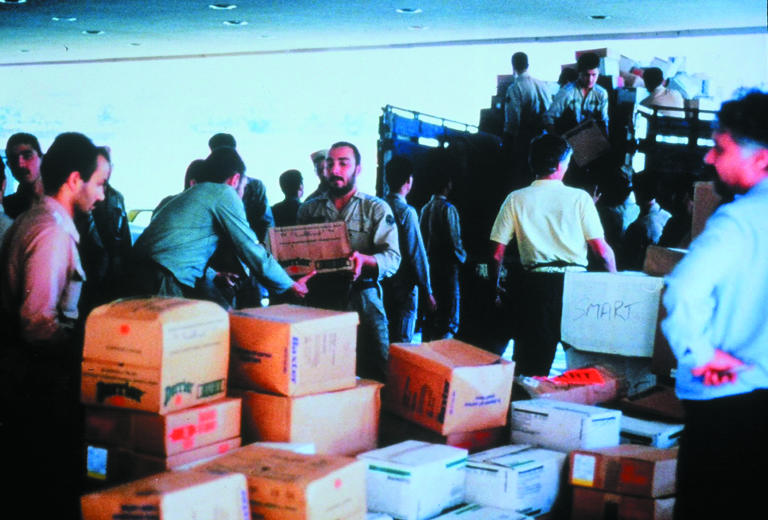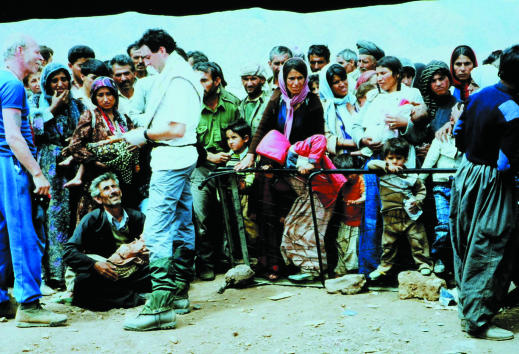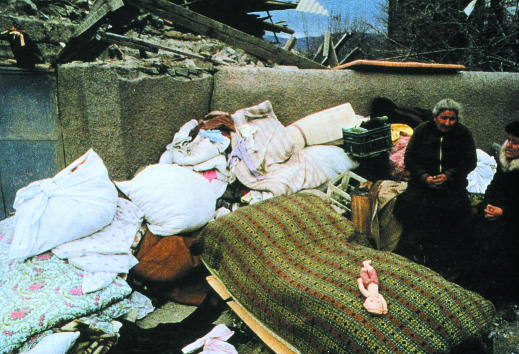As many as two billion people are at risk of or exposed to crisis conditions, and some 20 million people live in such conditions. Communities are exposed to crisis conditions when local and national systems are overwhelmed and are unable to meet their basic needs. This may be because of a sudden increase in demand (when food and water are in short supply) or because the institutions that support communities are weak (when government and local services collapse because of staff shortages or lack of funds).
Figure 1.
Triage of patients in a refugee camp on the Iran-Iraq border
Crises can be triggered by:
Sudden, catastrophic events—such as earthquakes, hurricanes, flooding, or industrial incidents
Complex, continuing emergencies—including the 100 or so conflicts currently under way, and the many millions of people displaced as a result
Slow onset disasters—such as widespread arsenic poisoning in the Ganges delta, the increasing prevalence of HIV infection and AIDS, or economic collapse.
Importance of needs assessment
The immediate global reporting of crises can and often does provoke cries of “Something must be done.” Laudable as such sentiments might be, if that something is not what is needed, its uninvited dispatch can only divert already stretched human and physical resources away from the task in hand.
Figure 2.
Homeless survivors of earthquake
If aid is to do the most good for the most people it must be targeted. To do this, a rapid needs assessment should be carried out as soon as possible and in direct consultation with local authorities. The resuscitation of a population is similar to the resuscitation of a severely injured patient, with needs assessment as the all important primary survey.
Those making the assessments should be experienced and recognised as acting on behalf of international agencies. However, too many assessments can waste time, unnecessarily duplicate effort, and frustrate the host community. Sharing and comparing information allows a clearer and more consistent picture to emerge, and smaller agencies can increase the speed and relevance of their response by referring to the reports of large international agencies and browsing relevant websites.
Whatever is done at the start must shorten and not prolong the recovery period and, most importantly, not increase dependency. Without attention to the local economy, food aid can destroy the local market and wipe out self sufficiency. If donated equipment is unfamiliar or cannot be maintained locally, its impact and useful life are limited and its introduction is more likely to devalue and undermine local practice than to support it.
The nature of the disaster
The type of incident will determine the scale and type of consequences. For example, earthquakes and landslides cause crush injuries, and volcanoes cause breathing problems. All large scale incidents, but particularly conflicts, create the mass movement of people. The geography, climate, and weather will determine physical access to the disaster area. Political instability will influence the feasibility of the humanitarian response.
Table 1.
The assessment team
| • The team must be self sufficient in food, water, shelter, medical supplies, transport, and communications |
| • A practical team size is often two to six people, splitting into teams of two once in the country |
| • While one assessor does the talking, a companion listens, observes, and takes notes. In this way little is missed or misinterpreted |
A United Nations disaster assessment and coordination (UNDAC) team is a two to six person team drawn from member countries that travels quickly to a disaster scene to report the immediate needs to the international community
The impact of the disaster
The number of people killed immediately by an event is an obvious measure of its impact. However, the number of survivors is more important. When subsequent death rates are measured, the number should be compared with the international standard of one death per 10 000 population per day.
Table 2.
Assessing a disaster by mortality*
| Adults and children aged ≥5 years | Children aged <5 years | ||
|---|---|---|---|
| ≤1 | Under control | ≤1 | “Normal” in a developing country |
| >1 | Serious condition | <2 | Emergency under control |
| >2 | Out of control | >2 | Emergency in serious trouble |
| >4 | Major catastrophe | >4 | Emergency out of control |
Mortality per 10 000 population per day
Close attention should be paid to the most vulnerable groups, particularly children, whose health will provide early warning of any growing threat. When communicating need, highlight the needs of the most vulnerable first.
Prioritising needs
Although the medical needs of the affected population might seem to be the most pressing issue, lack of non-medical necessities is usually the most immediate threat to life.
Figure 3.

Material aid should be targeted on identified needs
Drinking water—People die of thirst long before they starve. The greatest immediate threat is always lack of adequate drinking water. Because humans require so much water, its quality must be balanced against its quantity: an adequate quantity of reasonably safe water is preferable to a smaller quantity of pure water. For most aspects of emergency relief, it is important to avoid “temporary” holding measures, which often fail to be replaced and become inadequate longer term measures. However, the urgency of supplying water is so great that temporary systems to meet immediate needs must often be installed, to be improved or replaced later.
Table 3.
Rquirements for an emergency water supply
| • Minimum maintenance requirements (including hygiene needs) are 15-20 litres per person each day |
| • A feeding centre should aim to provide 20-301/person/day and a health centre to provide 40-601/person/day |
| • Safe storage should be provided near to homes |
Sanitation—After water, the greatest need is for sanitation. Once again, pragmatism dictates that the swift provision of a basic system will save more lives than the delayed provision of a perfect system. Ensure there is at least one latrine seat for every 20 people and that each dwelling is no more than one minute's walk from a toilet. For every 500 people there must be at least one communal refuse pit measuring 2 m × 5 m × 2 m.
Table 4.
Assessing malnutrition in children aged under 5 years
| • Middle upper arm circumference (MUAC) is a rough guide to nutritional status: normal > 14.0 cm, severe malnutrition <11.0 |
| • A malnutrition emergency is when > 10% of children are moderately malnourished |
| • Weight for height ratio (z score) is more accurate than MUAC but is more complex to calculate |
Food—The minimum maintenance level of food energy intake is accepted internationally as 2100 kcal (8.8 MJ) per person per day. When this falls below 1500 kcal (6.3 MJ) a day mortality rises rapidly in populations already stressed. Locally prepared food with local ingredients is best received and therefore of greatest use. Moreover, the purchase of local ingredients by local and international agencies supports the local economy and is sustainable. If food cannot be obtained locally then the provision of dried imported food still allows local preparation.
Table 5.
Trigger levels for urgent action
| Rise in mortality |
| • Crude mortality > 1/10 000/day |
| • Mortality in children aged <5 years >4/10 000/day |
| Fall in energy supply |
| • <1500 kcal/day in adults |
| • <100 kcal/kg/day in infants and small children |
| • Reduced z score or MUAC in 10% of children aged <5 years |
| • Wasting >15% of normal body weight |
Shelter—The effects on social infrastructure, particularly housing, must be assessed at an early stage and permanent shelter established as soon as possible. “Temporary housing” is rarely replaced and should be avoided. The minimum floor area for a human to live in dignity is 3.5 m2 per person. Clothing is often sent to stricken areas, but its transport is expensive and its storage can be difficult and costly. Financial support to larger agencies is usually the better way of addressing such needs.
Table 6.
Common infectious diseases associated with disasters
| • Acute respiratory infections |
| • Cholera |
| • Other diarrhoeal diseases |
| • Measles |
| • Malaria |
| • Meningits |
Medical needs—The most important medical issues will be infectious diseases. Children younger than 5 years are most vulnerable. Foreign emergency medical aid is often required, but usually in the form of materials rather than people. World Health Organization emergency health kits can be dispatched quickly and are available to match populations of varying size. Although primary care needs are paramount, limited support to secondary care is sometimes appropriate.
Table 7.
WHO emergency health kits
| • Basic and supplementary units available |
| • Each unit intended to assist a population of 10 000 for 3 months |
| •Entire unit fits on back of standard pick up truck |
| • Basic unit weighs 45 kg, 0.2 m3 in size Contains only oral drugs |
| • Supplementary unit Weighs 410 kg, 2 m3 in size For sole use of health professionals Does not duplicate basic unit and cannot be used alone |
International search and rescue teams—The publicity such teams attract can mask their limitations, and their uninvited arrival diverts precious resources. Remember that the survivors of a disaster provide most rescue effort and that survival from entrapment declines rapidly after 24-36 hours. The times when international search and rescue teams might be needed are when:
A large urban area has been affected
Buildings of more than two stories have collapsed
Collapsed buildings may have left spaces where victims could survive
Local facilities are inadequate.
Assessment of existing response
Local response
The impact of the disaster on a community is the product of the number of people affected minus their ability and capacity to cope. Quickly establish what the situation was like before the crisis; if necessary assess an unaffected area. Find a familiar point of reference; hospitals can provide a reasonable reflection of the wider community and are often readily accessible to those with a medical background and experience.
Figure 4.
Unrequested and inappropriate aid left abandoned at a local airfield
Identify what has been done so far and what immediate inputs would be of greatest help to local efforts. Identify key local players and direct any aid workers who follow you to the local authorities.
Table 8.
Key tasks for WHO in response to humanitarian crises
| • Assessment and analysis, anticipation and forecasting |
| • Coordination of relief agencies involved |
| • Identifying gaps in preparation and response |
| • Helping strengthen local capacity to prepare for and deal with crises |
Try to distinguish between emergency and chronic needs. Support what local structure exists, as imposing foreign organisational structures is ineffective and indeed destructive in a crisis.
International response
Establish which international agencies are already at the scene and which are expected. Competition is wasteful, so encourage cooperation between agencies and the sharing of information. Encourage and support the local authorities to establish and run a coordination centre for international relief agencies. The WHO and United Nations are usually best placed to liase between local government and relief agencies. UN disaster assessment and coordination (UNDAC) teams now try to establish an on site operations and coordination centre for this purpose. Coordination and cooperation are the keys to maximising the international effort.
Table 9.
Making recommendations for humanitarian aid
| • Identify the level and type of assistance required |
| • Give a timescale |
| • Clarify whether the need is for people or materials |
| • Keep it simple |
| • Support the local economic structure |
| • Ensure sustainability |
Making recommendations
Logistics—Whatever you recommend will be sent to those in need only if it can be procured, dispatched, and delivered on time. Assess the status and capacity of airports, seaports, and roads and the availability of trucks and drivers.
Table 10.
Issues to be addressed in evaluations of refugee health programmes
| • Appropriateness and cost effectiveness of the response |
| • Coverage and coherence of the response |
| • Connectedness and impact of the response |
Future developments—Find out what the local authorities plan to do next. Support the development of a clear strategy and encourage outside agencies to conform to and work within this framework.
Setting priorities—When identifying needs, clarify which are immediate, which are medium term, and which are longer term.
Although the urge to give “things” and send people can be powerful, cash contributions will often best support the local economy by the purchase of local goods and materials. Remember, a recommendation to do nothing, either at all or at the present moment, can be a valid and helpful conclusion. If the local community is coping, the inappropriate or untimely dispatch of aid can add to, rather than relieve, the burden of the affected country.
Anthony D Redmond is emeritus professor of emergency medicine, Keele University, North Staffordshire.
The WHO contributed to the writing of this article.
Competing interests: None declared.
The ABC of conflict and disaster is edited by Peter Mahoney, honorary senior lecturer, Academic Department of Military Emergency Medicine, Royal Centre for Defence Medicine, Birmingham; Anthony D Redmond; Jim Ryan, Leonard Cheshire professor, University College London, London, and international professor of surgery, Uniformed Services University of the Health Sciences (USUHS), Bethesda, MD USA; and Cara Macnab, research fellow, Leonard Cheshire Centre of Conflict Recovery, University College London, London. The series will be published as a book in the autumn.
Further reading and resources
- • OCHA (United Nations Office for the Coordination of Humanitarian Affairs) ochaonline.un.org
- • Unicef. www.unicef.org
- • World Health Organization. www.who.int





